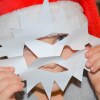6 Quick and Easy Kids Experiments with Wintry Ice

It was a snow-themed episode of “Daniel Tiger’s Neighborhood” that got my preschooler curious about the wonders of winter. As we watched Daniel and Miss Elaina put on their winter gear and make an astronaut snowman, my daughter wanted to have snow day fun, too. Yet, we live in an area with a climate with an average high temperature of 65 degrees in January. How could I harness my child’s curiosity and recreate the magic of a snow day right at home?
Ice experiments are relatively mess-free and build on a child’s interest in snow and winter. Simple science experiments are a great way to boost early learning STEM skills for children. As the National Association for the Education of Young Children recommends, we can value children’s questions, find answers together and invite curiosity while using objects from our homes.
Here are six quick ideas to experiment with wintry ice in your home:
1. Make frozen juice popsicles. Pour a favorite low-sugar juice into an ice cube tray or muffin tin and place a popsicle stick in the center. Monitor what happens when the liquid is placed in the freezer after one hour, two hours and overnight. Help your child make observations on how long it takes to transform the juice from liquid to solid. Once frozen, enjoy the icy treat!
2. Experiment and predict with melting ice. Place one ice cube on a plate, one in a bowl of cold water and one in a bowl of warm water. Make predictions on which will melt first. Have your child make a chart to document what happens to each piece of ice. Identify which one melts first, second and third. Then, think of ways to keep it from melting. For older children, try experimenting with salt, sugar and tap water with this PBS KIDS“What Makes Ice Melt Fastest?” activity. You might consider using this “Ready, Jet, Go” “Ice Cubes and Water: Now and Later” guide.
3. Make secret sidewalk messages. Enjoy this clip from “Peep and the Big Wide World,” and head to the driveway or sidewalk on a sunny day. Using ice cubes, have fun exploring the melting ice on the pavement. Trace, draw, or write secret messages with the ice cubes and watch as they disappear.
4. Make colorful ice artwork. Place a piece of chalk in a small bag and use a rolling pin or hard frying pan to grind the chalk into small pieces. In a small bowl, mix the ground chalk and water until well-blended. Pour the mixture into an ice cube tray and place it in the freezer. After the cubes are frozen, use them on black construction paper to make beautiful ice chalk art. Share your artwork on your next video call with faraway friends and family.
5. Does it sink or float? Place ice in a bowl of water and observe how it floats on top. Then place small, waterproof objects in the bowl to discover if they float or sink. Use a mixture of items of various sizes, shapes and weights.
6. Color mixing with ice. Make different colored ice cubes with all-natural food coloring. Then place two different colors in a bowl and watch as they melt and mix in color. Have children make predictions on what colors might form, and document the process with a chart or draw it on paper. You might also consider adding colored ice cubes to different low-sugar juice to observe how it changes in color.
While you might not be busting out the hats and gloves on a cold wintry day, you can still have fun together with ice. Remember, you don’t need scientific equipment to support early science. A little imagination, curiosity and investigating can go a long way toward boosting these skills.
Resources
- PBS LearningMedia. “Peep and the Big Wide World” “Paint with Water”
- PBS KIDS for Parents. “What Makes Ice Melt Fastest?”
- PBS LearningMedia “Ready, Jet, Go”“Ice Cubes and Water: Now and Later”
- PBS Parenting Minutes “Limiting Soda & Sweet Drinks”

